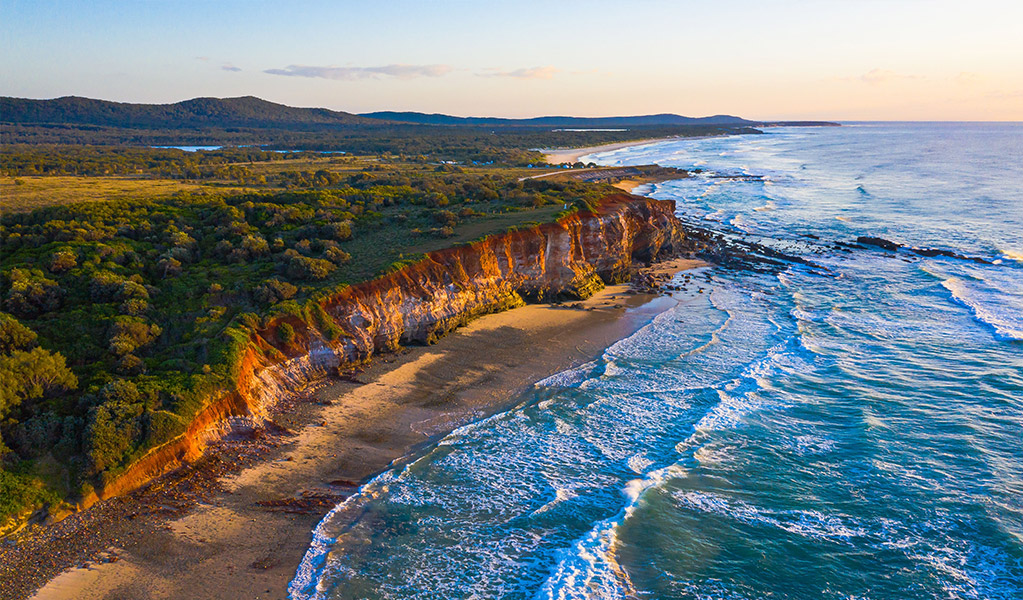Yuraygir National Park
Open, check current alerts
Overview
Located between Yamba and Coffs Harbour, Yuraygir National Park is perfect for beach camping, walking and group excursions. Avid hikers will enjoy the 65km Yuraygir coastal walk, while others might prefer whale watching, swimming and fishing.
Read more about Yuraygir National Park
Positioned on the NSW north coast between Yamba and Coffs Harbour, Yuraygir National Park boasts the state’s longest stretch of undeveloped coastline.
With 65km of striking cliffs, rocky headlands, isolated beaches and quiet lakes set against a backdrop of forests, heaths and wetlands, this colossal park is a place to experience, not just see.
Discover rare wildlife, remote campgrounds, idyllic picnic spots, and charming villages dotted along the coast. Swim, fish or surf to your heart’s content in this aquatic playground. Bring your binoculars for whale watching between May and September, or challenge yourself on the multi-day Yuraygir coastal walk; a four-day hike over 65km through striking coastal scenery.
Local alerts
For the latest updates on fires, closures and other alerts in this area, see https://www.nationalparks.nsw.gov.au/visit-a-park/parks/yuraygir-national-park/local-alerts
Map
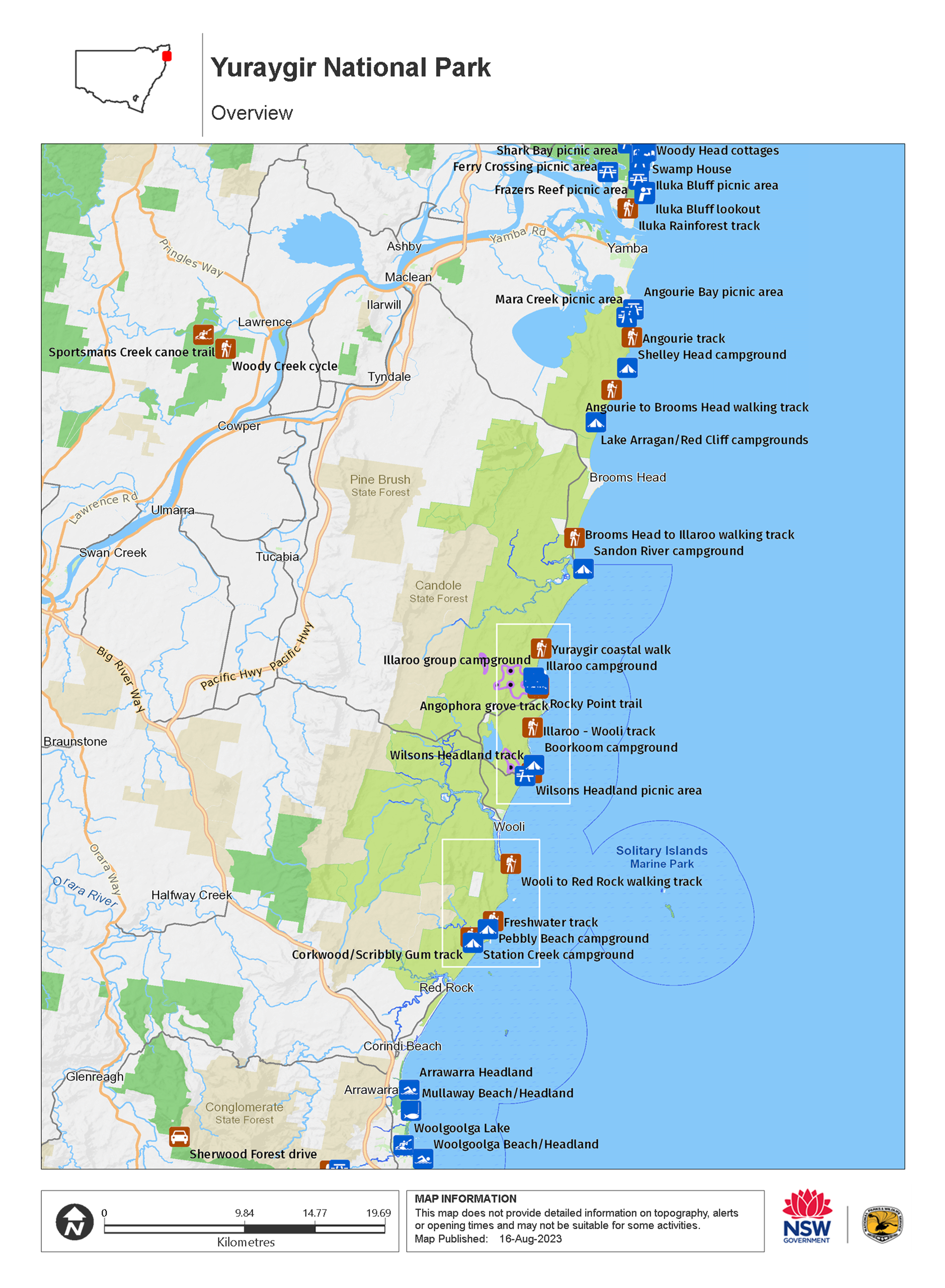
Map
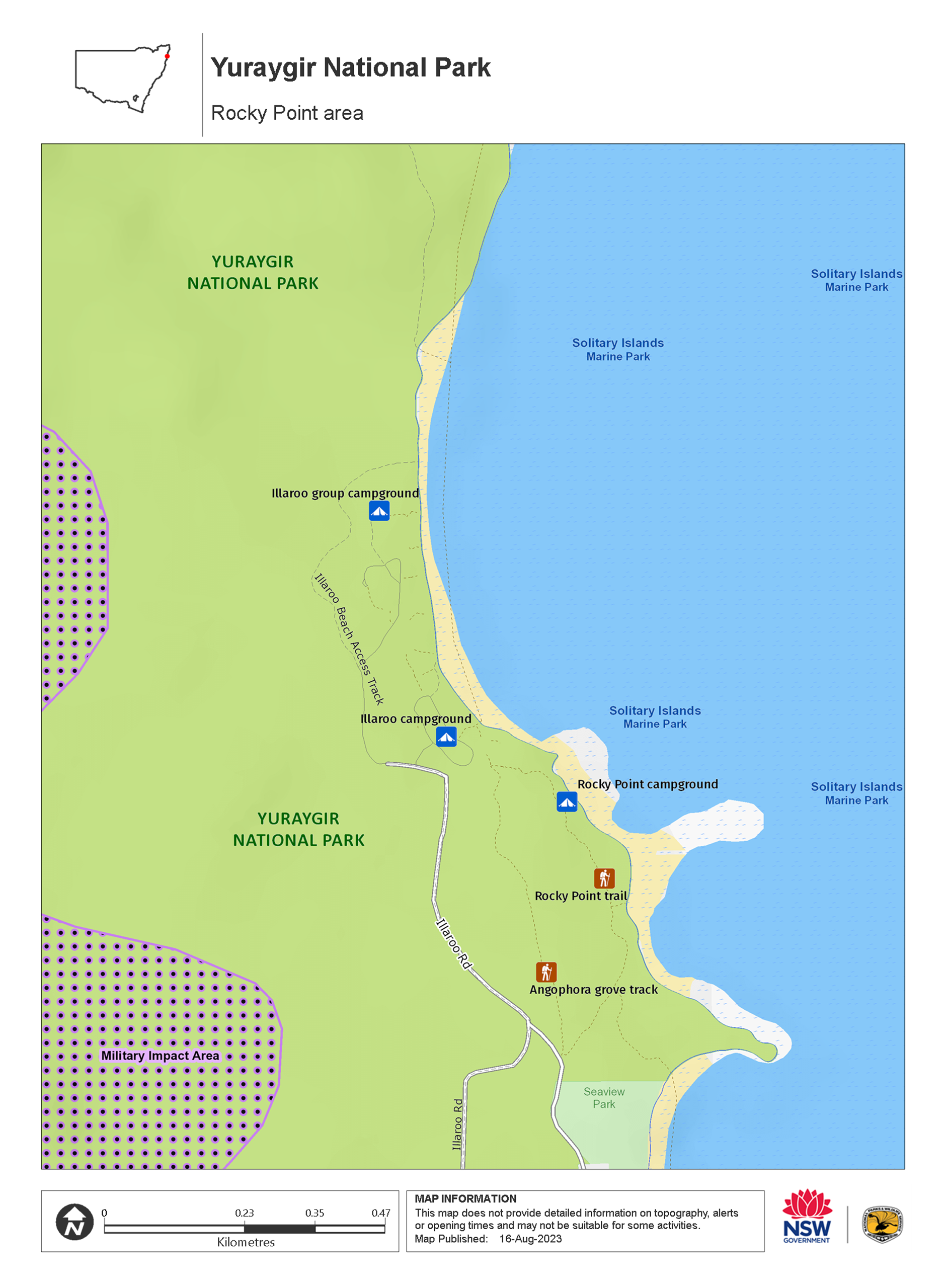
Map
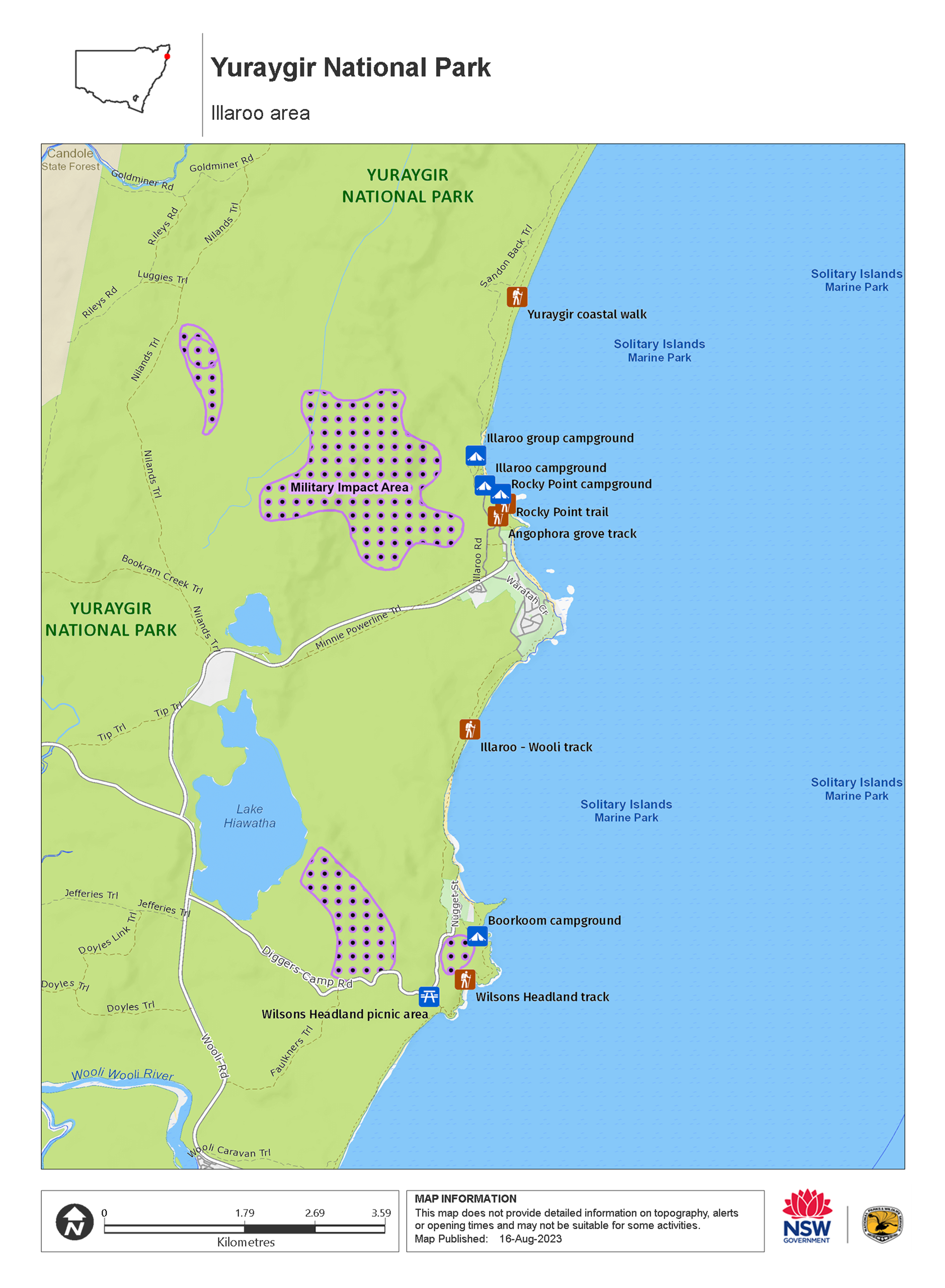
Map
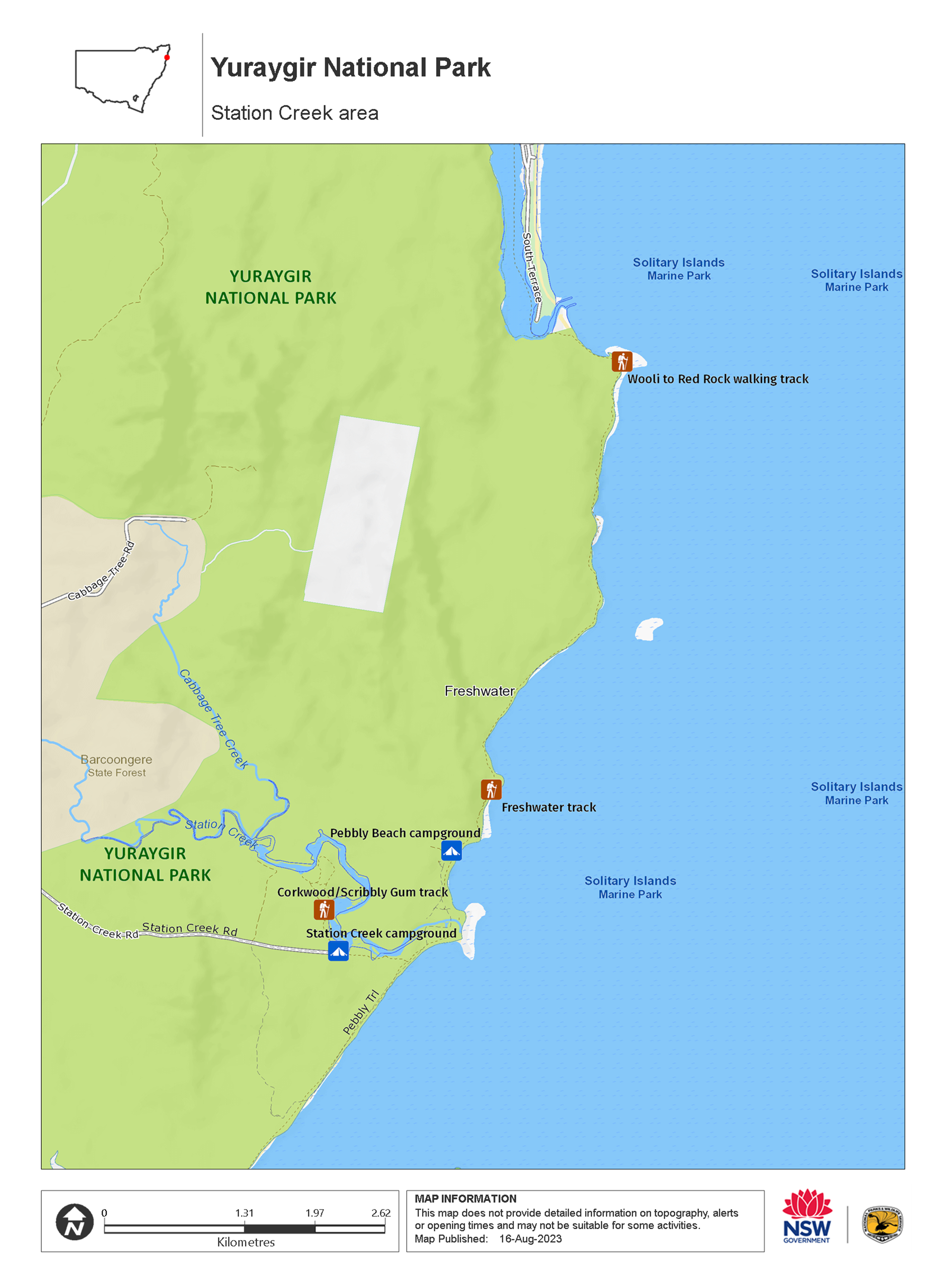
Map legend

Contact
- in the North Coast region
Yuraygir National Park is always open but may have to close at times due to poor weather or fire danger.
-
Park entry fees:
$8 per vehicle per day.
Buy annual pass. -
-
Grafton office
02 6641 1500
Contact hours: Monday to Friday, 8.30am to 4.30pm. - Level 4, 49 Victoria Street, Grafton NSW 2460
-
Email: npws.clarence@environment.nsw.gov.au
-
Grafton office
Visitor info
All the practical information you need to know about Yuraygir National Park.
Getting there and parking
Get driving directions
From Grafton:
- Drive south on the Pacific Highway for 10km, then take the Wooli and Minnie Water turnoff.
- Continue for 25km then, at the T-intersection, turn left to Minnie Water to get to Illaroo camping area, or right to Wooli.
- From Wooli Road, turn left onto Diggers Camp Road to get to the Boorkoom camping area and Wilsons Headland picnic area.
From Maclean:
- Take Brooms Head Road through Gulmarrad
- After 19km, turn left to reach the campgrounds at Lake Arragan, Red Cliff and Grey Cliff
- Turn right off Brooms Head Road and travel along the Sandon Road for 9km to get to the Sandon River camping area
From Coffs Harbour:
From Coffs Harbour, travel north on the Pacific Highway for 49km, then turn right onto McPhillips Road. Its about 12km from the Highway to Station Creek Campground.
Parking
- Angourie Bay picnic area See on map
- Lake Arragan and Red Cliff campgrounds See on map
- Wilsons Headland picnic area See on map
By bike
Check out the Bicycle information for NSW website for more information.
Best times to visit
There are lots of great things waiting for you in Yuraygir National Park. Here are some of the highlights.
Autumn
Autumn is the perfect time of year to go beach fishing along the park's coastline.
Spring
The park's heathlands provide a spectacular display of wildflowers. Check them out on your choice of walking track, including the Wilsons Headland walk and, of course, the Yuraygir coastal walk.
Summer
Visit in summer to make the most of the park's countless beaches and waterways. Swim, surf or snorkel – cooling sea breezes provide welcome relief in hot weather.
Winter
Plan a winter trip to go whale watching. The sight of migrating whales swimming north to warmer waters is second-to-none, and there are magnificent viewing points at Red Cliffs lookout and Brooms Head.
Weather, temperature and rainfall
Summer temperature
Average
20°C and 26°C
Highest recorded
42.5°C
Winter temperature
Average
9°C and 20°C
Lowest recorded
2.7°C
Rainfall
Wettest month
March
Driest month
September
The area’s highest recorded rainfall in one day
300mm
Facilities
Amenities
Toilets Show more
- Angourie Bay picnic area
- Angourie to Brooms Head walking track
- Angourie walking track
- Boorkoom campground
- Illaroo campground
- Illaroo group camping area
- Lake Arragan and Red Cliff campgrounds
- Mara Creek picnic area
- Pebbly Beach campground - Yuraygir National Park
- Sandon River campground
- Shelley Head campground
- Station Creek campground
- Wilsons Headland picnic area
Picnic tables Show more
- Angourie Bay picnic area
- Angourie to Brooms Head walking track
- Boorkoom campground
- Illaroo campground
- Illaroo group camping area
- Lake Arragan and Red Cliff campgrounds
- Mara Creek picnic area
- Sandon River campground
- Shelley Head campground
- Station Creek campground
- Wilsons Headland picnic area
Barbecue facilities Show more
Boat ramp
Drinking water
Public phone
Maps and downloads
Fees and passes
Park entry fees:
$8 per vehicle per day.
- All Parks Pass - For all parks in NSW (including Kosciuszko NP) $190 (1 year) / $335 (2 years)
- Multi Parks Pass - For all parks in NSW (except Kosciuszko) $65 (1 year) / $115 (2 years)
- Country Parks Pass - For all parks in Country NSW (except Kosciuszko) $45 (1 year) / $75 (2 years)
- Single Country Park Pass - For entry to a single park in country NSW (except Kosciuszko). $22 (1 year) / $40 (2 years)
Annual passes and entry fees (https://www.nationalparks.nsw.gov.au/passes-and-fees)
Prohibited
Pets
Pets and domestic animals (other than certified assistance animals) are not permitted. Find out which regional parks allow dog walking and see the pets in parks policy for more information.
Smoking
NSW national parks are no smoking areas.
Nearby towns
Wooli (15 km)
Yuraygir National Park protects the longest stretch of undeveloped coastline (60km) in NSW. Coastal hideaways worth exploring include Wooli, Minnie Waters and Brooms Head.
Grafton (35 km)
Grafton is a gracious, historic city in the Clarence Valley farming district. It's situated on the broad Clarence River and surrounded by river flats.
Yamba (36 km)
Yamba is a bustling holiday resort with a large fishing fleet. It's built around a headland at the mouth of the Clarence River.
Learn more
Yuraygir National Park is a special place. Here are just some of the reasons why:
Treasured culture

The landscape of Yuraygir National Park has been, and remains, the Country of Aboriginal groups. Generations of Yaegl and Gumbaynggirr People camped, fished and held ceremonies here and numerous areas remain of strong spiritual significance to the Aboriginal community. Take the Freshwater Walk and view the most impressive pandanus palms - this important Gumbaynggirr ceremonial plant was used to weave neckbands, dillybags and baskets.
- Brooms Head to Illaroo walking track Brooms Head to Illaroo walking track, part of Yuraygir coastal walk, is a hiking route with river crossings, beach walking, scenic coastal views and birdwatching opportunities.
Precious and protected

At Yuraygir, you can see some of the country’s most vulnerable native wildlife up close, such as squirrel gliders and eastern grass owls. See if you can spot a rufous bettong, a rarely-seen rabbit-sized marsupial also know as the rufous rat-kangaroo. Or even the shy Queensland blossom-bat, Australia’s smallest fruit bat. The threatened green and golden bell frog is one of the 25 amphibians within Yuraygir – likely to be found around swamps, lagoons and flood plains. Keep an eye out for coastal emus, once so prevalent and now, sadly an endangered species with fewer than 100 left in the park.
- Wilsons Headland walking track The easy Wilsons Headland walking track is ideal for whale watching along the Clarence Coast. Starting at Boorkoom campground, the hiking track offers scenic coastal views.
- Yuraygir coastal walk Hike the multi-day Yuraygir coastal walk on the Clarence Coast near Yamba. You’ll find loads of places for whale watching, snorkelling and swimming, with overnight stops at beach campgrounds.
Important landscapes

When you visit Yuraygir, you're entering one of the most diverse bioregions in Australia. Wander past age-old coastal landforms, littoral rainforest, eucalypt forest, woodland and wetlands - much of which simply wouldn't be there without the park's protection. Pay a visit to Shelley Headland to see the state's most significant remaining example of grassy clay heath.
- Angourie to Brooms Head walking track Angourie to Brooms Head walking track, part of Yuraygir coastal walk, is a hiking route offering scenic lookouts and opportunities for beach walking, birdwatching, and seasonal whale watching.
- Yuraygir coastal walk Hike the multi-day Yuraygir coastal walk on the Clarence Coast near Yamba. You’ll find loads of places for whale watching, snorkelling and swimming, with overnight stops at beach campgrounds.
- Yuraygir guided treks with Home Comforts Hiking Home Comforts Hiking offers guided treks of Yuragir coastal walk with overnight accommodation in 4 charming coastal villages. It’s a great way to explore this beautiful coastline near Yamba and Coffs Harbour.
A watery wonderland

The park not only boasts a superb coastline but also features rivers, lakes and estuaries, so swimmers and snorkelers are spoilt for choice. Remember your fishing rod - the waters off the park are excellent for jewfish and groper, and Sandon River is among the state's most popular fishing spots. If surfing is your thing, you can't beat the legendary Angourie Surfing Reserve - it hosts what's arguably Australia's best right-hand point break. Yuraygir is also a paddler's paradise, its sheltered waterways provide the ideal setting for canoeing, kayaking and boating.
- Angourie Bay picnic area After surfing or swimming at the Clarence Coast’s famous Angourie Headland, stop off at the scenic Angourie Bay picnic area for a tasty picnic lunch with the family.
- Wooli to Red Rock walking track Wooli to Red Rock walking track, part of Yuraygir coastal walk, is a moderate hiking route with river crossings, scenic coastal views and great opportunities for birdwatching.
Plants and animals protected in this park
Animals
-

Eastern ground parrot (Pezoporus wallicus wallicus)
The eastern ground parrot is a beautiful, ground-dwelling native bird that lives in low heathland habitat along the NSW North and South coasts and escarpments. It’s listed as a vulnerable species in NSW.
-

White-bellied sea eagle (Haliaeetus leucogaster)
White-bellied sea eagles can be easily identified by their white tail and dark grey wings. These raptors are often spotted cruising the coastal breezes throughout Australia, and make for some scenic bird watching. Powerful Australian birds of prey, they are known to mate for life, and return each year to the same nest to breed.
-

Yellow-tailed black cockatoo (Calyptorhynchus funereus)
The yellow-tailed black cockatoo is one of the largest species of parrot. With dusty-black plumage, they have a yellow tail and cheek patch. They’re easily spotted while bird watching, as they feed on seeds in native forests and pine plantations.
-

Emu (Dromaius novaehollandiae)
The largest of Australian birds, the emu stands up to 2m high and is the second largest bird in the world, after the ostrich. Emus live in pairs or family groups. The male emu incubates and rears the young, which will stay with the adult emus for up to 2 years.
-

Brown-striped frog (Lymnastes peronii)
One of the most common frogs found in Australia, the ground-dwelling brown-striped frog lives in ponds, dams and swamps along the east coast. Also known as the striped marsh frog, this amphibian grows to 6.5cm across and has a distinctive ‘tok’ call that can be heard all year round.
-

Australian pelican (Pelecanus conspicillatus)
The curious pelican is Australia’s largest flying bird and has the longest bill of any bird in the world. These Australian birds are found throughout Australian waterways and the pelican uses its throat pouch to trawl for fish. Pelicans breed all year round, congregating in large colonies on secluded beaches and islands.
-

Green and golden bell frog (Litoria aurea)
The green and golden bell frog is an endangered Australian frog. Once common on the NSW coast and tablelands, populations have plummeted around 90 percent.
Plants
-

Grass tree (Xanthorrea spp.)
An iconic part of the Australian landscape, the grass tree is widespread across eastern NSW. These Australian native plants have a thick fire-blackened trunk and long spiked leaves. They are found in heath and open forests across eastern NSW. The grass tree grows 1-5m in height and produces striking white-flowered spikes which grow up to 1m long.
Environments in this park
What we're doing
Yuraygir National Park has management strategies in place to protect and conserve the values of this park. View the detailed park and fire management documents. Here is just some of the work we’re doing to conserve these values:
Conserving our Aboriginal culture
NPWS works cooperatively with local Aboriginal communities. Ongoing programs are in place to support this relationship in Yuraygir National Park, with continuing efforts to preserve the park’s cultural values for future generations.
Preserving biodiversity
Yuraygir National Park is committed to upholding biodiversity and does this by protecting rare, vulnerable, threatened and endangered species. Cooperative conservation programs are regularly carried out in this park, and include surveying, data collection on species distribution and population, weed control activities and systematic fire ecology inventories. Local community groups are regularly engaged in conservation efforts.
Managing weeds, pest animals and other threats
Pests and weeds have a significant impact to the ecosystems within Yuraygir National Park. NPWS carries out risk assessments for new and emerging weeds as well pest reduction of foxes, wild dogs, cane toads and bitou bush to protect biodiversity in this park.
Developing visitor facilities and experiences
NPWS works to promote positive experiences in NSW national parks. To ensure visitor safety, comfort and enjoyment, all facilities in Yuraygir National Park are regularly maintained, upgraded or developed as required. The park regularly reviews its processes and systems, implementing new ideas and technologies as appropriate to ensure ease of access and optimal visitor experiences. Maintenance programs are ongoing.
General enquiries
- National Parks Contact Centre
- 7am to 7pm daily
- 1300 072 757 (13000 PARKS) for the cost of a local call within Australia excluding mobiles
- parks.info@environment.nsw.gov.au
Contact
- in the North Coast region
Yuraygir National Park is always open but may have to close at times due to poor weather or fire danger.
-
Park entry fees:
$8 per vehicle per day.
Buy annual pass -
-
Grafton office
02 6641 1500
Contact hours: Monday to Friday, 8.30am to 4.30pm. - Level 4, 49 Victoria Street, Grafton NSW 2460
-
Email: npws.clarence@environment.nsw.gov.au
-
Grafton office

